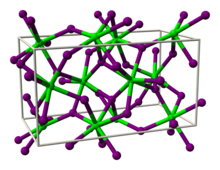Chemistry:Strontium iodide

| |
| Names | |
|---|---|
| IUPAC name
Strontium iodide
| |
| Identifiers | |
| |
3D model (JSmol)
|
|
| ChemSpider | |
| EC Number |
|
PubChem CID
|
|
| RTECS number |
|
| UNII | |
| |
| |
| Properties | |
| SrI2 (anhydrous) SrI2·6H2O (hexahydrate) | |
| Molar mass | 341.43 g/mol (anhydrous) |
| Appearance | Colorless to white crystalline plates |
| Density | 4.55 g/cm3 (anhydrous)[1] 4.40 g/cm3 (hexahydrate)[1] |
| Melting point | 507 to 645 °C (945 to 1,193 °F; 780 to 918 K)[3] |
| Boiling point | 1,773 °C (3,223 °F; 2,046 K) (decomposes) |
| 177.0 g/100 mL (20 °C)[2] | |
| Solubility in ethanol | 3.1 g/100 ml (4 °C) [2] |
| −112.0·10−6 cm3/mol | |
| Structure | |
| Orthorhombic, oP24 | |
| Pbca, No. 61 | |
| Hazards | |
| Main hazards | Corrosive |
| GHS pictograms | 
|
| GHS Signal word | Danger |
| H314 | |
| P280, P305+351+338, P310 | |
| NFPA 704 (fire diamond) | |
| Related compounds | |
Other anions
|
strontium fluoride strontium chloride strontium bromide |
Other cations
|
beryllium iodide magnesium iodide calcium iodide barium iodide |
Except where otherwise noted, data are given for materials in their standard state (at 25 °C [77 °F], 100 kPa). | |
| Infobox references | |
Strontium iodide (SrI2) is a salt of strontium and iodine. It is an ionic, water-soluble, and deliquescent compound that can be used in medicine as a substitute for potassium iodide .[5] It is also used as a scintillation gamma radiation detector, typically doped with europium, due to its optical clarity, relatively high density, high effective atomic number (Z=48), and high scintillation light yield.[6] In recent years, europium-doped strontium iodide (SrI2:Eu2+) has emerged as a promising scintillation material for gamma-ray spectroscopy with extremely high light yield and proportional response, exceeding that of the widely used high performance commercial scintillator LaBr3:Ce3+. Large diameter SrI2 crystals can be grown reliably using vertical Bridgman technique [7] and are being commercialized by several companies.[8][9]
Reactions
Strontium iodide can be prepared by reacting strontium carbonate with hydroiodic acid:
Strontium iodide forms a white powder that slowly changes to a yellowish colour when exposed to air. At high temperatures (in the presence of air) strontium iodide completely decomposes to form strontium oxide and free iodine.[10]
References
- ↑ Jump up to: 1.0 1.1 Yaws, C.L. (2008). Thermophysical properties of chemicals and hydrocarbons. William Andrew. ISBN 978-0-8155-1596-8. https://books.google.com/books?id=31O4upzTHQwC.
- ↑ Jump up to: 2.0 2.1
177 g/100 mL (20 °C) Seidell, Atherton (1907), Solubilities of Inorganic and Organic Substances, New York: D. Van Nostrand, pp. 318, https://books.google.com/books?id=7Y8AAAAAMAAJ&pg=PA318, retrieved 2007-12-10 - ↑ Turner, Jr., Francis M., ed. (1920), The Condensed Chemical Dictionary, New York: The Chemical Catalog Company, pp. 449, https://books.google.com/books?id=y8y0XE0nsYEC&pg=PA449, retrieved 2007-12-10
- ↑ "Strontium iodide". Sigma Aldrich. https://www.sigmaaldrich.com/AU/en/product/ALDRICH/400696.
- ↑ Shoemaker, John V. (1908), A Practical Treatise on Materia Medica and Therapeutics (7th ed.), Philadelphia: F. A. Davis, pp. 854, https://books.google.com/books?id=E-1xq8ScRD8C&pg=RA1-PA854, retrieved 2007-12-10
- ↑ Prettyman, Thomas; Burger, Arnold; Yamashita, Naoyuki; Lambert, James; Stassun, Keivan; Raymond, Carol (2015). "Ultra-bright scintillators for planetary gamma-ray spectroscopy". SPIE Newsroom. doi:10.1117/2.1201510.006162. ISSN 1818-2259.
- ↑ Datta, A.; Lam, S.; Swider, S.; Motakef, S. (October 2016). "Crystal growth of large diameter strontium iodide scintillators using in Situ stoichiometry monitoring". 2016 IEEE Nuclear Science Symposium, Medical Imaging Conference and Room-Temperature Semiconductor Detector Workshop (NSS/MIC/RTSD). pp. 1–4. doi:10.1109/NSSMIC.2016.8116640. ISBN 978-1-5090-1642-6.
- ↑ Inc., CapeSym. "CapeSym | SrI2(Eu)". http://www.capesym.com/sri2.html.
- ↑ "Strontium Iodide | RMD" (in en-US). http://rmdinc.com/strontium-iodide/.
- ↑ Bartley, Elias H. (1898), Text-book of Medical and Pharmaceutical Chemistry (5th ed.), Philadelphia: P. Blakiston, pp. 267–268, https://books.google.com/books?id=qdwUkA_aHWsC&pg=PA267, retrieved 2007-12-10
| HI | He | ||||||||||||||||
| LiI | BeI2 | BI3 | CI4 | NI3 | I2O4, I2O5, I4O9 |
IF, IF3, IF5, IF7 |
Ne | ||||||||||
| NaI | MgI2 | AlI3 | SiI4 | PI3, P2I4 |
S | ICl, ICl3 |
Ar | ||||||||||
| KI | CaI2 | Sc | TiI4 | VI3 | CrI3 | MnI2 | FeI2 | CoI2 | NiI2 | CuI | ZnI2 | Ga2I6 | GeI2, GeI4 |
AsI3 | Se | IBr | Kr |
| RbI | SrI2 | YI3 | ZrI4 | NbI5 | Mo | Tc | Ru | Rh | Pd | AgI | CdI2 | InI3 | SnI4, SnI2 |
SbI3 | TeI4 | I | Xe |
| CsI | BaI2 | HfI4 | TaI5 | W | Re | Os | Ir | Pt | AuI | Hg2I2, HgI2 |
TlI | PbI2 | BiI3 | Po | AtI | Rn | |
| Fr | RaI2 | Rf | Db | Sg | Bh | Hs | Mt | Ds | Rg | Cn | Nh | Fl | Mc | Lv | Ts | Og | |
| ↓ | |||||||||||||||||
| La | Ce | Pr | Nd | Pm | SmI2 | Eu | Gd | TbI3 | Dy | Ho | Er | Tm | Yb | Lu | |||
| Ac | ThI4 | Pa | UI3, UI4 |
Np | Pu | Am | Cm | Bk | Cf | EsI3 | Fm | Md | No | Lr | |||
 |


